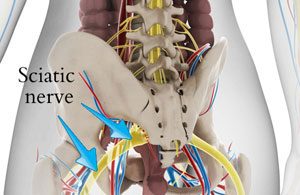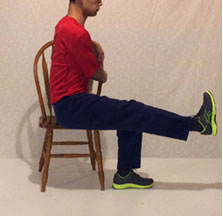12 Simple Ways That Will Help Your Sciatica Related Pain
By Sherwin Nicholson | Updated May 1, 2020

Sciatica is a very common type of radicular pain
Your Sciatic Nerve
It is literally a pain in your behind. And it hurts you when you least need it to. Both when you’re either trying to work or rest. Heck, you can even feel it when you’re standing.
One of the worst things you can do to trigger sciatic nerve pain is to rely on a career that forces you to sit in excess of 6+ hours per day. So if you are ‘stuck in this position’ often, then you need the following help.
Don’t let it get to you. There is help. I have listed 12 tips to help you feel better. But for now, it helps to know more about what it actually is and whether you really have it.
When your sciatic nerve gets irritated from pressure, you’ll feel a very sharp, painful sensation. It can worry and scare you. It can make you feel like your whole lower body is in pain because of where it travels from your spine.
If it hurts you a lot right now in the office and at your desk, you can get relief here with these 5 Tips.
And since it’s the longest nerve in the body, the intensity is pretty alarming.
It originates and exits from the bottom of the spinal column as a group of 5 to 6 smaller nerves. These nerves then combine to form the large nerve that travels down through the hip and down to the bottom of your leg. There is one nerve for each side of the body.
Pain from sciatica can be felt anywhere from the lower lumbar and sacral nerves, passing through the buttocks, down the thigh, leg and foot. It is also known as a radicular form.
If it hurts you a lot right now in the office and at your desk, you can get relief here with these 5 Tips.
People may be led to believe that this is a medical condition. It is not.
It is actually a way of describing the symptoms felt when pressure is applied in the lumbar region but felt on any part of this nerve from the lumbar column to the foot.
A Common Cause of Sciatica
One common cause is if you have a lumbar disc bulge. Too much pressure on your disc can cause the disc wall to weaken. As it weakens, part of the wall bulges out toward the nerve, causing nerve pain and numbness. It is usually the last two discs in the lumbar spine, the L4-L5 and the L5-S1. These discs compress the L4, L5 and S1 nerve roots.
We tend to abuse and wear out our lowest two discs. It even happens when you age, so it’s important how well you treat your back in your youth.

How do I know if I have true Sciatica?
Here is a quick and simple test you can down right now to help identify it:
- Sit on a table or chair without leaning against the back rest
- Begin with upright posture and your legs bent at right angles
- Your thigh should be level with the seat and the shins vertical
- Keeping your thigh on the seat, straighten the leg which has pain symptoms, elevating the foot
If it hurts and you feel like leaning backward to reduce the discomfort, then you have a possible pinched nerve. Extending the knee causes a pull on the sciatic nerve. If it is pinched, then the pull of the stretch will cause pain.
If your facet joint becomes irritated and swollen, this increase in size can cause similar nerve symptoms also. When there is degenerative disc disease, the disc and vertebrae can amplify the pressure. Degenerative conditions include osteophyte formation and osteoarthritic conditions. These changes also cause it to hurt even more.
Temporary Sciatica?
There are some situations where it is temporary, such as pregnancy and hormonal changes that increase swelling in the area of the nerve.
When yours is mild
Pain can range from slight discomfort to a sharp, persistent and debilitating sensation. The symptom depends on which part of the nerve is compressed. If the nerve is affected for a long time, the muscle that this nerve itself supplies may weaken and show deficiencies.
When it has worsened
If your condition is allowed to progress, the nerve can become damaged, and you may not be able to lift the forepart of the foot. Other problems of the foot include not being able to push off on the toes. An issue with walking may occur where there is ‘foot drop’. This is where your foot may drop or drag on the ground as you walk.
What about Piriformis Syndrome?
Almost like sciatica but not, and it comes from your behind and not the back.
A large muscle of the buttock, known as the Piriformis muscle runs over this muscle.
Injury, swelling and tightness of your piriformis can irritate this nerve, triggering a sciatic condition known as Piriformis Syndrome. There are some some excellent exercises available to alleviate this condition. Here is an easy and effective stretch that can help you.
Other Causes of Sciatica
- Disc rupture
- Osteoarthritis
- Osteophyte formation
- Pregnancy and hormones
- Poor lifting
- Posture
- Excess weight
- Incorrect exercises and movements
- Poor back support
- Poor muscle conditioning
- Piriformis syndrome
Here are the 12 Practical and Effective Tips to Help You
- If you have sharp pain, then stop and rest. Do not continue with your activity
- Avoid Sitting for long periods and if you must, then move around every 30 minutes for at least 5 minutes
- Avoid using a back support when you sit. If you must rely on them, then minimize your time
- Rely on using only your posture to maintain sitting upright similar to a pianist
- Don’t sit on furniture with poor support: couches, sofas or anything that allows you to lean backwards
- Lie down stretched out on your stomach or sides when your symptoms worsen
- Use a cool pack against the lumbar area
- Take an anti-inflammatory but only as a needed
- Use a warm pack if the symptoms are not relieved with the cool pack
- See your family doctor or health care professional
- When symptoms are manageable perform simple stretches to relieve muscle tightness
- Improve your flexibility and tightness in your buttocks areas to relieve nerve pressure
Tip 13: Begin A Low Impact, Exercise and Stretch Routine for relief
This will help you to correct your pelvic tilt, strengthen your abs, release tension in your back and pressure from your piriformis muscle which can make you feel worse.
Low impact exercise will provide a safe, easy and effective treatment. It helps to correct the imbalances on the lumbar discs and recondition the muscles affected by the sciatic nerve. It also helps to reduce any pressure that the muscles themselves put on the sciatic nerve. There are some very helpful exercises that will help with you here.
If you are looking for an easy, careful and long-term plan to help with your issues of sciatica and lower back pain, follow the Program that helps It provides the necessary exercises and stretches beneficial to relieving your symptoms.
For More Information:
Do you have glute pain (buttocks)
Tips for your back and sciatic pain
Keeping motivated when it really hurts
References:
For references, see the Sitewide references page.
